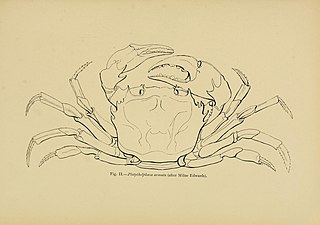
Lake Kivu is one of the African Great Lakes. It lies on the border between the Democratic Republic of the Congo and Rwanda, and is in the Albertine Rift, the western branch of the East African Rift. Lake Kivu empties into the Ruzizi River, which flows southwards into Lake Tanganyika.

Platythelphusa is a genus of freshwater crabs endemic to Lake Tanganyika. It has been placed in a number of families, including a monotypic family, Platythelphusidae, as well as Potamidae and its current position in the Potamonautidae, and has also been treated as a subgenus of Potamonautes. It forms a monophyletic group, possibly nested within the genus Potamonautes, which would therefore be paraphyletic. The genus is the only evolutionary radiation of crabs to have occurred in a freshwater lake, and it occurred recently, probably since the Pliocene. This parallels the better known radiation of cichlid fishes in Lake Tanganyika. Only one other species of freshwater crab is found in Lake Tanganyika, Potamonautes platynotus.

Potamonautes is a genus of African freshwater crabs in the family Potamonautidae. It is both the most widespread and most diverse genus of African freshwater crabs, including more than half the species of this continent. They are found in most freshwater habitats of the African mainland and some species are semi-terrestrial.
Potamonautes berardi is a species of freshwater crab in the family Potamonautidae. It is found in the Nile Basin in Egypt, Ethiopia, Sudan, Tanzania and Uganda. Its natural habitats are rivers and streams.
Potamonautes didieri is a species of crab in the family Potamonautidae. It is endemic to the Democratic Republic of the Congo, but has not been observed for 100 years; it is therefore listed as Data Deficient on the IUCN Red List.
Potamonautes gerdalensis is a species of crustacean in the family Potamonautidae. It is found in the Democratic Republic of the Congo, Kenya, Tanzania, and Uganda. Its natural habitats are rivers and freshwater lakes. It is threatened by habitat loss.
Potamonautes gonocristatus is a species of crustacean in the family Potamonautidae. It is endemic to Lake Kivu, on the border between the Democratic Republic of the Congo and Rwanda.
Potamonautes idjiwiensis is a species of crustacean in the family Potamonautidae. It is endemic to the island of Idjwi in Lake Kivu, the Democratic Republic of the Congo. Its natural habitats are streams and other freshwater habitats.

Potamonautes johnstoni is a species of freshwater crab in the family Potamonautidae. It is found in rivers in Kenya and Tanzania, with unconfirmed records from Malawi and the Democratic Republic of the Congo. The species' distribution includes Kilimanjaro, Nekona, Mrogoro and the Usambara Mountains.

Potamonautes lirrangensis, the Malawi blue crab, is a species of freshwater crab in the family Potamonautidae. This common and widespread species is found in Lake Malawi, Lake Kivu, the upper Congo River Basin and Malagarasi River in the Democratic Republic of the Congo, Malawi, Rwanda, and Tanzania. In the freshwater aquarium trade it is sometimes sold under the synonym Potamonautes orbitospinus.
Potamonautes loveni is a species of crab in the family Potamonautidae. It is found in Kenya and Uganda. Its natural habitat is rivers.
Potamonautes niloticus is a species of freshwater crab in the family Potamonautidae. It is found in the Nile Basin in Egypt, Ethiopia, Rwanda, Sudan, and Uganda. Numerous specimens of P. niloticus are known from Miocene deposits around Lake Albert.
Potamonautes obesus is a species of crab in the family Potamonautidae. It is found in Kenya, Malawi, Mozambique, Somalia, Tanzania, Zambia, and Zimbabwe. Its natural habitat is swamps.
Potamonautes platycentron is a species of freshwater crab in the family Potamonautidae, which is endemic to Lake Chala in Kenya and Tanzania. It was originally described by Franz Martin Hilgendorf in 1897, as Telphusa platycentron.
Potamonautes platynotus is a species of freshwater crab which is endemic to Lake Tanganyika, where it is the only freshwater crab outside the genus Platythelphusa. Although primarily aquatic, P. platynotus is sometimes seen out of water, and can survive for many hours without water.
Potamonautes raybouldi is a species of freshwater crab. It lives in water-filled tree holes in forests in the eastern Usambara Mountains of Tanzania and the Shimba Hills in Kenya. It is threatened by deforestation resulting from the expansion of the human population, and is listed as a vulnerable species on the IUCN Red List. The species was described in 2004, and named after Professor John N. Raybould of the University of Bristol, who collected the first specimens of the species.
Potamonautes rukwanzi is a species of crustacean in the family Potamonautidae. It is endemic to Uganda. Its natural habitat is freshwater lakes.

Potamonautidae is a family of freshwater crabs endemic to Africa, including the islands of Madagascar, the Seychelles, Zanzibar, Mafia, Pemba, Bioko, São Tomé, Príncipe and Sherbro Island. It comprises 18 extant genera and 138 extant species. Fossil remains dating from the Late Miocene period have been attributed to the family Potamonautidae.

Potamonautes sidneyi is a species of freshwater crab in the family Potamonautidae. The common name is the Natal river crab or Sidney's river crab, although they may also be referred to as "river crabs", "fresh water crabs" or "land crabs".

Around 1,300 species of freshwater crabs are distributed throughout the tropics and subtropics, divided among eight families. They show direct development and maternal care of a small number of offspring, in contrast to marine crabs, which release thousands of planktonic larvae. This limits the dispersal abilities of freshwater crabs, so they tend to be endemic to small areas. As a result, a large proportion are threatened with extinction.







